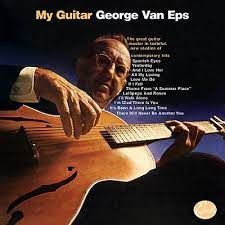
Daily Dose Of Jazz…
George Abel Van Eps was born on August 7, 1913 in Plainfield, New Jersey into a family of musicians. His mother was a classical pianist, his father was a ragtime banjoist and sound engineer and his three brothers were musicians. He began playing banjo at eleven years old but after hearing Eddie Lang on the radio, he devoted himself to guitar. By thirteen, in 1926, he was performing on the radio.
Through the middle of the 1930s, he played with Harry Reser, Smith Ballew, Freddy Martin, Benny Goodman, and Ray Noble. Van Eps moved to Los Angeles, California and spent most of his remaining career as a studio musician, playing on many commercials and movie soundtracks.
In the 1930s, he invented a model of guitar with another bass string added to the common six-string guitar. The seven-string guitar allowed him to play bass lines below his chord voicings, unlike the single-string style of Charlie Christian and Django Reinhardt. He called his technique “lap piano”, as it anticipated the fingerpicking style of country guitarists Chet Atkins and Merle Travis and inspired jazz guitarists Bucky Pizzarelli, John Pizzarelli, and Howard Alden to pick up the seven-string.
Dixieland had a following in Los Angeles during the 1940s and 1950s, and he played in groups led by Bob Crosby and Matty Matlock and appeared in the film Pete Kelly’s Blues. He played guitar on Frank Sinatra’s 1955 album. In The Wee Small Hours.
Playing guitar into his eighties, he built a career that lasted over sixty years. Swing and mainstream guitarist George Van Eps, who recorded eleven albums as a leader and thirty~two as a sideman, transitioned from pneumonia on November 29, 1998 in Newport Beach, California at the age of 85.
More Posts: guitar,history,instrumental,jazz,music


